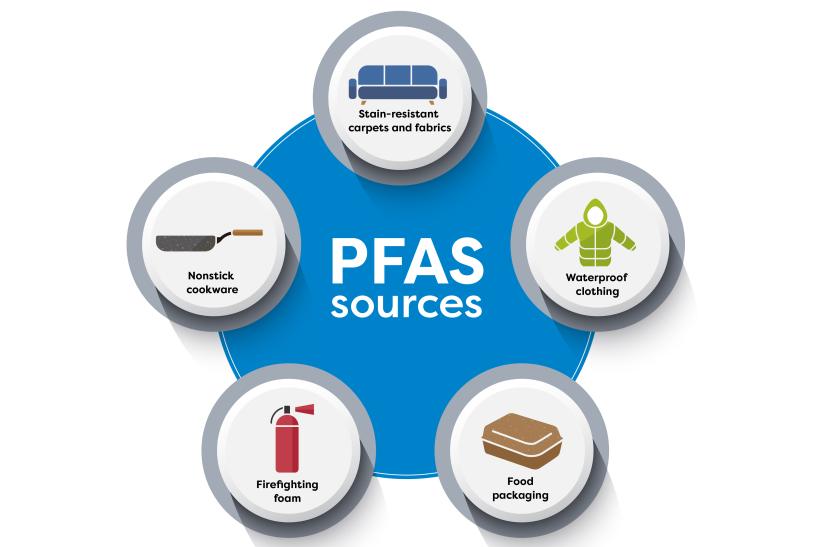What are PFAS?
PFAS are a group of thousands of human-made chemicals that resist heat, oils, stains and water. They have been widely used in consumer products like nonstick cookware, stain-resistant carpets and fabrics, waterproofing clothing, and food packaging. They have also been used in industrial processes and firefighting foams. PFAS are often called “forever chemicals” because they break down very slowly and can accumulate in humans, animals, and the environment. PFAS have been found in water, air, and soil worldwide. PFOA and PFOS are two common PFAS chemicals.
How are people exposed to PFAS?
Most people have been exposed to PFAS through consumer products, but drinking water can be another exposure source. The major sources of PFAS in water supplies are fire training and response sites where fire-suppressing foam was applied, industrial sites, landfills, and wastewater treatment plants/biosolids. Because of their persistence in the environment, PFAS can accumulate in water supplies.
Are there limits for PFAS in drinking water?
Yes, on April 10, 2024, the U.S. Environmental Protection Agency (EPA) established a Maximum Contaminant Level (MCL) of 4 parts per trillion (ppt) for PFOA and PFOS and 10 ppt for PFNA, PFHxS, and GenX. The rule also regulates combined amounts of four other types of PFAS chemicals (PFNA, PFHxS, PFBS, and GenX).
Public water systems will need to monitor their water supply for these chemicals within three years and include the results in their Annual Water Quality Reports to customers. Systems that detect PFAS above the drinking water limits will have up to five years to implement solutions, such as treatment or other actions, to ensure water delivered to customers does not exceed these limits. Water systems must also notify the public if levels of regulated PFAS exceed these new standards. For more information, please visit epa.gov/sdwa/and-polyfluoroalkyl-substances-pfas.
What is Valley Water doing about PFAS?
We take our responsibility to provide safe, clean water and to protect groundwater very seriously. Valley Water has been proactively evaluating the threat posed by PFAS through voluntary sampling and coordination with other agencies. Our water quality laboratory is accredited to test for PFAS in drinking water.
Valley Water and our water retailers use proven technologies and best practices to ensure drinking water delivered to businesses and residents meets or exceeds all drinking water standards. Valley Water continues to collaborate with regulatory agencies and water retailers to assess impacts on local supplies and to evaluate potential sources and treatment technologies. Valley Water will also continue to provide timely, transparent communication to customers and the public.
How can PFAS in drinking water be treated?
Some public water systems may need to treat their source water to ensure that the water delivered to customers meets drinking water limits. Various treatment technologies, including activated carbon, reverse osmosis, and ion exchange, can reduce PFAS.
If you are concerned with PFAS in your water, please contact your water provider for information on whether PFAS are present in the water delivered to your area. If you are interested in a home treatment system, PFAS can be reduced by certain filters installed on faucets, whole-house systems, or pitcher-type filters. If considering a home treatment system to reduce PFAS:
- Check the product packaging or specifications for NSF/ANSI 53 or NSF/ANSI 58 certification to reduce PFAS.
- Confirm this certification through a reputable, independent testing agency like NSF (see link below).
- Follow the manufacturer’s instructions for maintenance and filter replacement. Proper maintenance is essential to ensure the system reduces PFAS as designed.
More information on PFAS treatment options can be found at:
- epa.gov/system/files/documents/2024-04/water-filter-fact-sheet.pdf
- epa.gov/sciencematters/reducing-pfas-drinking-water- treatment-technologies
- nsf.org/news/pfoa-pfos-reduction-claims-requirements- added-to-nsf-standards
What can I do to reduce PFAS exposure?
Did you know the EPA estimates only 20% of human exposure to PFAS comes from drinking water? People can also be exposed to PFAS through in consumer products and packaging, certain foods, or even soil, dust, and air.
Additional PFAS resources




